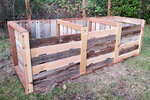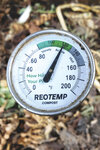

When we built our vegetable garden more than a decade ago, complete with raised beds and an 8-foot tall fence, it included three compost bins. We hailed from Seattle with a small yard. The only thing I grew to eat there were tomatoes, and all my yard and kitchen waste went into a big bin hauled off by the city.
I had much to learn, and I concentrated first on learning what to grow, when to plant, and how much to feed and water.
Composting was relegated to the back burner. I threw stalks and leaves from the garden into the composting bins. I read about mixing brown and green, needing to keep the pile moist, but it all felt overwhelming, and the bins pretty much just sat there untended. Given enough time — three to 10 years — just about anything will decompose, but I knew there was a better way.
Last April I received Earth Matters, the annual newsletter from Pierce County. The emphasis was on food waste, with pointers on how to avoid wasting food with good menu planning and food storage. They also offered classes on composting. I signed up.
The classes were great, but there is also nothing like local expertise, so I reached out for advice from the Key Pen Gardeners Facebook group.
Sharron Dean has lived on the Key Peninsula for 18 years but got serious about composting four years ago when her husband built her composting bins. She uses one to store leaves and the other two for composting. Adding a composting thermometer raised her composting to a new level. “I’ve decided compost is to gardening as sourdough is to baking,” she said.
By paying attention to the proportion of green to brown content, as well as volume, moisture and aeration, she can turn her yard and kitchen waste into compost in a few months.
Green content means nitrogen-rich things like grass clippings, garden trimmings, coffee grounds, fruits and vegetable trimmings from the kitchen. Brown means carbon-rich things like dried leaves, sawdust and straw.
Typical compost bin plans are 3-foot cubes, with three built side-by side. A bin that is half full will have enough volume to heat up.
Judge the brown to green ratio by volume, with two parts brown to one part green. The process works best if everything is cut into pieces about 2-3 inches long.
“I add things to one bin, alternating green and brown items, until I feel like the pile has enough mass to really start breaking down,” Dean said. “Of course, some things have been breaking down since I started putting them in, but other things at the top are completely intact,” she said. “At that point I stop adding anything new.”
It’s important to have enough moisture, about the texture of a damp sponge. It is hard to overwater a compost bin much of the year, but keeping a lid on during the rainy winter months will keep it from getting too wet.
Aeration is critical to keeping the compost process active, and monitoring the temperature helps guide the process.
“I use the compost thermometer to see how hot the interior is. If I have a good mix of stuff in there, the temperature will rise quickly to 140 or 150 degrees and stay there for a week or two,” Dean said. “Then it starts to slowly decline. Once it gets back to around 80 degrees, I’ll pull a few wheelbarrow loads out just so I can physically turn what remains in the bin. Then I’ll add back the stuff I took out, add some water if it seems dry, and let it start the process over.”
Not every pile will get to 150 degrees, but 90 to 120 will actively break things down into good compost.
The Pierce County composting system at the Purdy transfer station follows a process remarkably like Dean’s, though at an industrial scale. The ratio of brown and green is the same. They use a massive grinder to chop everything up and heavy equipment to turn, but like a good home composter they pay attention to moisture and use temperature to guide when they aerate. The Purdy compost gets to a temperature higher than most home systems reach, enough to kill seeds.
The Gig Harbor Demonstration Garden in Sehmel Homestead Park, run by the Pierce County Master Gardener Program, has active compost bins. The garden is open on Wednesdays and Saturdays.
For more information, go to the “sustainability classroom” at www.piercecountywa.gov.
UNDERWRITTEN BY THE FUND FOR NONPROFIT NEWS (NEWSMATCH) AT THE MIAMI FOUNDATION, THE ANGEL GUILD, ADVERTISERS, DONORS AND PEOPLE WHO SUPPORT INDEPENDENT, NONPROFIT LOCAL NEWS